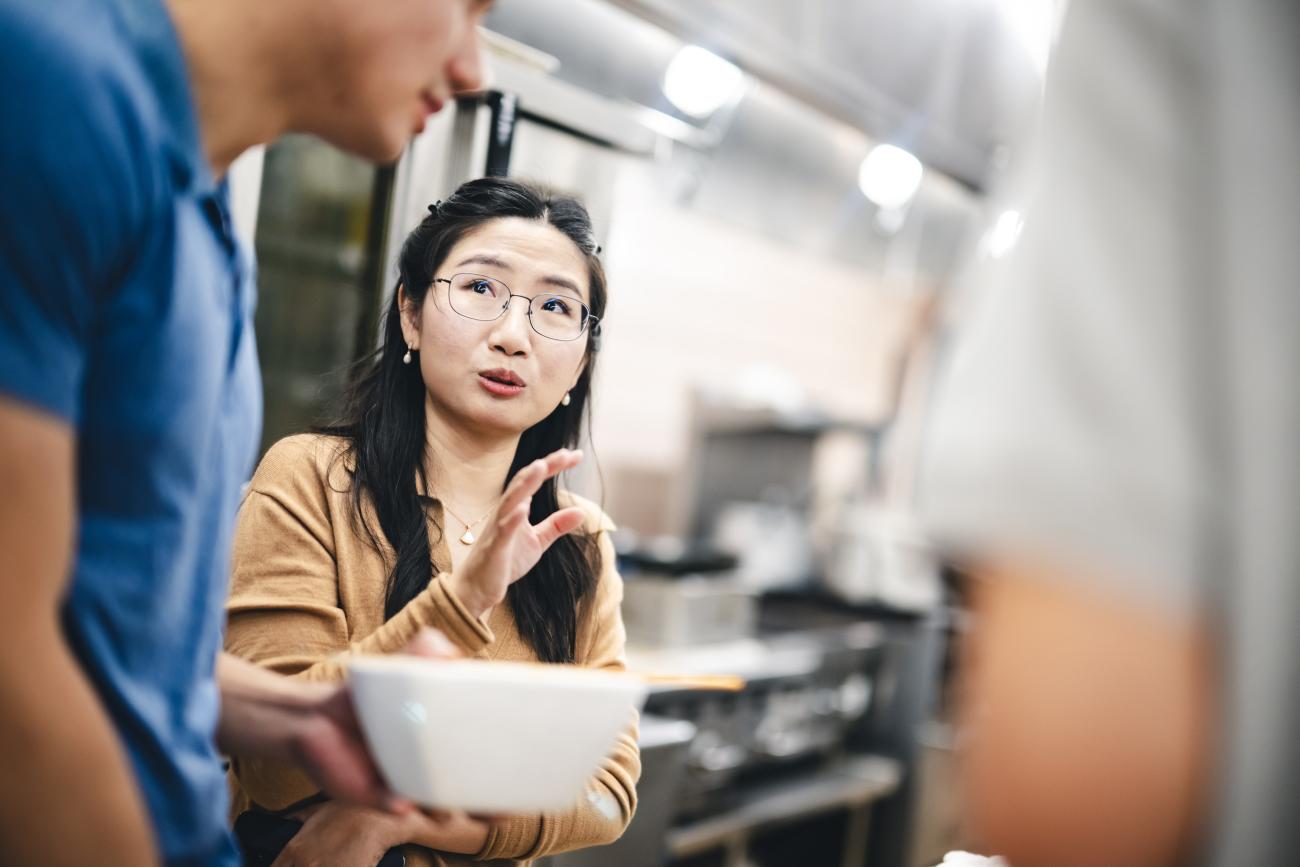Green Noodles and the Poetry of Food
Scholar of Chinese literature and gastronomic writing, Wandi Wang researches a 13th century Chinese cookbook
Dr. Seuss may have written about green eggs, but poet Du Fu 杜甫, one of the most important figures in Chinese literary history, wrote about green food 1200 years ago in his famous poem “Huai-Leaf Cold Noodles” 槐叶冷淘. The detailed recipe based on the poem appeared in Pure Offerings in the Mountains 山家清供, one of the oldest surviving standalone cookbooks in China, dating from the thirteenth century. Wandi Wang is translating the cookbook and has classified it not just as a collection of recipes, but as a masterpiece of literature.
Lin Hong 林洪 (fl. 1224–1263), the author of Pure Offerings in the Mountains, was known as a “Rivers and Lakes poet,” but most of his poetry was lost. Wang, assistant professor of Chinese, explains he wasn’t a scholar-official poet with a post because he didn’t pass China’s civil service examination at that time. The cookbook, while a way to attract attention, wasn’t just a cookbook like we’d imagine today. “He discussed a lot of poetry…He quoted his own poetry, as well as poetry from his contemporaries and earlier voices, to show that he was very knowledgeable,” Wang remarks.
Wang is working on a monograph, tentatively titled Taste and Gastropoetics in Traditional China, that explores gastronomic writings by literati in the Song dynasty (960–1279). “I focus on the Song dynasty because that's when gastronomic writings emerged,” she notes. In many ways, Song dynasty food culture marks China’s first historical moment that closely parallels the dynamics of modern gastronomic culture.
Part of her research includes offering the first complete translation of Pure Offerings in the Mountains with annotations and detailed analysis, a challenging task given that this is a relatively new field of study. Pure Offerings in the Mountains is not just a record for historical documentation but a way for Lin Hong to convey his values, morality, and political views. It’s also very beautifully written which is why Wang calls it “a lyrical cookbook.”
By using Pure Offerings in the Mountains, Wang is reconstructing the lost poet. The dishes in the collection reflect the aesthetics of Lin Hong and the pursuit of purity (qing 清). “[Purity] can mean a lot of things in Chinese culture, such as integrity, frugality, and in terms of food, this very subtle, refreshing kind of beauty, so most of the dishes in that cookbook are vegetarian and simple,” she says. “Lin Hong was pushing back against this very extravagant way of eating at that time, which was so prevalent, especially with richer families. And he was trying to say that, look, we can find beauty in those very rustic, simple, frugal ways of eating. So that dish [Huai-Leaf Cold Noodles] is actually a very good symbol of that.” Wang’s research on this cold noodle dish is featured in a forthcoming journal article, “Cold Noodles in the Song Dynasty: The Taste of Pure Experience.”
In the Kitchen
Wang regards sharing this recipe with her students as a valuable opportunity to incorporate her own research into her teaching. “Huai-Leaf Cold Noodles” were the basis for a food lab Wang conducted with her class in partnership with Lehigh Dining. She is teaching a course on “Food in Chinese Literature” which explores the history of gastronomic writings in China from antiquity to modern day.
Wang chose this recipe for the food lab not only because of its immense literary and cultural value, but because it is relatively simple and accessible to make, especially for amateur chefs.
“It’s the first colorful noodle dish in Chinese history,” Wang explains. “The color is emerald and beautiful, the fragrance is refreshing and herbal. It is a cold noodle dish, so it's very cooling, perfect for a summer day. The color, the temperature, the aroma, and the taste—everything—all come together to this aesthetic idea of Chinese ‘purity.’ I think that's very fascinating, and I hope the students can understand this by reproducing the dish.”
Wang’s translation of the original recipe from Pure Offerings in the Mountains described pounding leaves into juice, kneading the dough, and making the noodles. Wang offered they substitute spinach for the huai 槐 (sophora japonica), commonly known as the Chinese pagoda tree or Chinese scholar tree, just as many Chinese restaurants do.
In the modern day kitchen, Charlie Kresge, executive chef at Rathbone student restaurant, blanched the spinach first before students rang the leaves of its juices. It was with this green water that students created the dough with flour, egg, and salt. In this way, the recipe was less noodle and more pasta, yet the process of getting their hands sticky with dough conveyed the lesson that it only takes a little time and effort to make something delicious.
“I think food really connects your spirit and your body."

The original recipe mentioned vinegar and soy sauce to serve with the noodles to create a light and pure flavor, but students added chili oil and sriracha so noodles had a red hue. Contemporary student preferences lean toward bold and spicy tastes, Wang notes.
Chinese History and Culture
What makes Wang’s course so engaging is the passion she has for not only teaching the historical context but sharing gastronomic writing as a multisensory experience. “I think food really connects your spirit and your body. I think students can get that too, just by taking this class.”
Wang reads gastronomic writing as a hobby when she was a teenager. “I loved to read cookbooks, prose on food, poetry on food in classical Chinese,” she says. And when she moved to the United States for graduate school, she realized not everyone shared the same interest.
“My culture is my passion. But here, not everyone is necessarily interested in Chinese literature, especially classical Chinese poetry. They might be intimidated by that, and they might think it's something really old, which has nothing to do with our contemporary life,” Wang says. Yet food, on the other hand, connects people to their everyday lives.
“Students are always so enthusiastic talking about food, so I think this is a very good angle for them to learn a little bit about Chinese culture, history, and philosophy.”
“Everyone’s interested in Chinese food,” Wang concludes.

